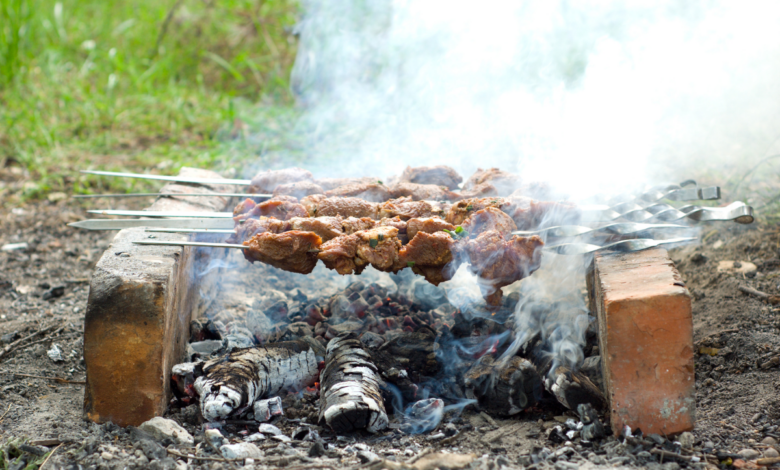How to Preserve Meat in the Wild? The Three Primary Methods

Replenishing your food supply whether you’re trying to survive in the woods or simply figuring out how to preserve meat on your homestead. One of the keys to self-sufficiency is learning how to keep a steady flow of protein in your belly.
We all know meat is a life-saving resource you need for energy.
And without a refrigerator at your disposal, your score can easily start turning and decomposing within a couple of hours.
The key aspects of preserving meat in the wilderness are to reduce the moisture content in the meat and prevent bacterial growth. There are three simple and time-tested ways to do it:
- Drying it in the sun
- Salting or curing
- Smoking
So, let’s take an in-depth look at how to preserve meat in the wild. A lot of our top tips came from the folks at Modern Homestead!
How to Preserve Meat in the Wild
The good news is you don’t need many tools to preserve and store meat in the wild.
The primary tool that you’ll use is a high-quality knife. It goes without saying that a knife is an essential part of any survival gear. You will need it for butchering the carcass and cutting the meat into strips.
Next, you need to build a fire as a source of heat and smoke. As a self-sufficient homesteader, you need to have a reliable method of building a fire. A fire starter kit can come in handy for the purpose.
To smoke the meat, another item you need is a smoke rack to place the meat over the fire. You can easily build a three-legged DIY rack by cutting a few branches with a saw.
The third factor isn’t in your control but you’ll need it anyway. Good and bright weather will help dry the meat properly. That means the task is going to be a real chore if you’re stuck in a wet rainforest.
Keep in mind, the whole process will take some time. Don’t make the mistake of speeding it up and letting the meat remain half-cured.
The Best Methods of Preserving Meat
Before you go into the actual preservation process, you need to lower the temperature of the meat. Fact is, lowering the temperature helps in limiting bacterial decomposition. The task is easier in cold conditions.
First, you need to clean the meat up properly. Remove the fat, bone, and connecting tissues that act as insulators and cut the meat up into thin slices. This will also promote airflow.
Wash off the blood and dirt using cold water. If you have a stream near your shelter, you can wash and cool it at the same time.
In case you have a game bag, use it to store the meat during the initial phase. It will also keep the flies away.
Drying
The easiest way to preserve meat is to dry it up. Allowing the sun to do all the hard work is one of the oldest methods of preserving meat. It was used in Native American culture and various other tribes as well.
So, how to dry meat in the wild?
Once you have cut the meat into thin strips simply place it in a clean and dry spot under the direct sun. When you cut it into thin slices, the meat dries more uniformly. Hanging the strips can also be an option.
Depending on the weather conditions, it can take anywhere between 18 to 24 hours for the meat to dry up. However, the process works best in dry conditions with consistent sunlight.
You can also heat a flat rock on fire and place the meat over it for drying.
Curing
In this process, you add table salt to the meat to dehydrate it. The salt draws out the water from the meat through the process of osmosis. As a result, the number of free water molecules in the meat decreases. The salt content in the meat also goes up.
This reduces the bacterial activity in the meat and prevents decomposition. In addition, salt also reduces the oxygen content in the meat to limit bacterial growth.
While table salt is good enough, you can also use special curing salt for the purpose. It contains sodium nitrate that prevents toxin formation in the meat.
Quite often, sugar is also added to the curing process. The exact role of sugar in the process isn’t clear. It’s assumed that it helps in stabilizing the meat by encouraging the growth of beneficial bacteria. Besides, sugar also adds flavor by reducing the harshness of salt.
There are two ways of curing meat.
- In dry curing, you rub salt and sugar on the meat slices and let them dry. The salt will increase the rate of drying. The standard practice is to use 6 pounds of salt and 3 pounds of sugar per 100 pounds of meat. The thin slices can take around 7 to 10 days for the process to complete.
- In wet curing, you prepare a solution by adding one cup of salt per gallon of water. You can also add sugar and other spices. Submerge the meat slices in the mixture for 5 minutes and then allow them to dry. Once it’s dry, rub an extra layer of salt on the surface. Allow the curing process to continue.
Note, the process of pickling meat is similar to wet curing. But in this process, the meat is immersed in brine or acidic solution (vinegar or wine) for a few days.
Make sure to dry the meat completely after the curing process. You can expect the meat to lose at least 30% of its weight once the process is complete.
Smoking
For a long-term survival scenario where you don’t anticipate having an unlimited supply of salt, smoking is the best alternative. It dries the meat and the chemicals present in wood smoke also act as preservatives.
Smoking not only dehydrates the meat but also adds flavor to it. Using hardwood is the best option for producing smoky flavors. Avoid using resinous softwoods like pine as they will turn the meat bitter. Also, don’t use wet wood as the smoke will cover the meat with harmful chemicals.
Remember, you’re not cooking the meat in the fire but literally bathing it in smoke. Ideally, the temperature of the meat should be around 100°F (38°C). The process can take as long as 48 hours to get completed.
There’s another process of smoking known as hot smoking. For this, you need a canopy over the fire. Since the temperatures are kept higher, this process takes less time. The canopy will also prevent the smoke from blowing away on a windy day.
Adding Preservatives
Using chemical preservatives is one of the easiest ways of preserving food. And one of the common chemicals used is citric acid which can prevent the growth of bacteria.
Even though citric acid is found in citrus fruits, collecting lemons during a survival situation shouldn’t be your plan. The best option is to buy citric acid powder. You can use 1 ½ oz. of the powder for 10 pounds of meat.
The process is similar to curing. In fact, you can also use citric acid for seasoning the meat during smoking and curing.
Factors of Safety in Eating Preserved Meat
The biggest problem with raw meat is, it can get contaminated easily. Moisture and a favorable temperature range between 40°F to 140°F promote bacterial growth. It’s important to keep this in mind depending on where your homestead is located.
Humid areas of the country like the South and possibly the Mid-Atlantic are going to require more careful storage.
The primary target of meat preservation is preventing the growth of microorganisms.
And even after preserving the meat, here are some precautions you need to take.
- Prevent contamination from water, dust, dirty hands, flies, and rodents. Make sure to store the meat in clean containers or Ziploc bags. Personal hygiene is extremely important when handling and cooking meat.
- Avoid eating any meat that looks dark brown or discolored and has a rancid or stale odor. Discard the item if it feels slimy or tough.
- Cook the meat at temperatures above 145°F (62.8°C). Allow the meat to rest at that temperature for at least three minutes before consuming it.
- Once cooked, don’t keep the meat at room temperature for more than two hours.
How Long Can Meat Last
The period for which the preserved meat will last depends on the ambient temperatures. Try to keep smoked or cured meat in cold environments to make it last longer. When refrigerated, they can last for two to three weeks.
In higher temperatures cured and smoked products can last between 3 to 5 days. If they are air-dried, the preservation period gets extended by a few days.
How to Prepare Preserved Meat to Eat
If the meat has been cured and fully dried, it can be eaten without cooking. However, the salty flavor might get to you after a while. Plus, if you’re in a prepping scenario, you’ll have to consume more water.
The easiest way to prepare preserved meat for cooking is by soaking and simmering it in boiling water. This also preserves the maximum nutrients. Or else, you can use the meat to prepare a stew.
The other option is frying the meat in a pan. You can also use a non-poisonous branch as a skewer and grill the meat over the fire.
Whatever the method, make sure to cook it for the right amount of time to prevent any contamination.
The other way of eating meat is to prepare jerky or pemmican with it. While it can take some time and effort, they are great options in a bug-out situation.
Struggling to pull in fish and game? Check out Larry Smith Outdoors for the latest and greatest tips on how to pull in more numbers and fill up your freezers and pantries this season!
Conclusion
No matter how you have planned to produce your own food to survive on the homestead, learning how to store and preserve protein, grains, and other foods is essential.
Once you know how to store meat in the wild, your hard work won’t go to waste.
And don’t forget…
These simple but effective methods were used by our forefathers who hunted mammoths in the wild.
So, make sure that you take advantage of them.




One Comment